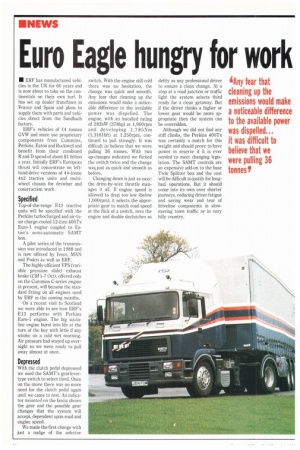Euro Eagle hungry for work
Page 16

If you've noticed an error in this article please click here to report it so we can fix it.
• ERF has manufactured vehicles in the UK for 60 years and is now about to take on the continentals on their own turf. It has set up dealer franchises in France and Spain and plans to supply them with parts and vehicles direct from the Sandbach factory.
ERF's vehicles of 14 tonnes GVW and more use proprietary components from Cummins, Perkins, Eaton and Rockwell and benefit from their combined R and D spend of about $1 billion a year. Initially ERF's European thrust will concentrate on lefthand-drive versions of 44-tonne 4x2 tractive units and multiwheel chassis for drawbar and construction work.
Specified
Top-of-the-range El 2 tractive units will be specified with the Perkins turbocharged and air-toair charge-cooled 12-litre 400Tx Euro-1 engine coupled to Eaton's semi-automatic SAMT box.
A pilot series of the transmission was introduced in 1988 and is now offered by Iveco, MAN and Foden as well as ERF.
The highly efficient VPS (variable pressure slide) exhaust brake (CM1-7 Oct), offered only on the Cummins C-series engine at present, will become the standard fitting on all engines used by ERF in the coming months.
On a recent visit to Scotland we were able to see how ERF's E12 performs with Perkins Euro-1 engine. The big six-inline engine burst into life at the turn of the key with little if any smoke on a cold wet morning. Air pressure had stayed up overnight so we were ready to pull away almost at once.
Depressed With the clutch pedal depressed we used the SAMT's gearlevertype switch to select third. Once on the move there was no more need for the clutch pedal again until we came to rest. An indicator mounted on the fascia shows the gear and the possible gear changes that the system will accept, dependent upon road and engine speed.
We made the first change with just a nudge of the selector
switch. With the engine still cold there was no hesitation, the change was quick and smooth. Any fear that cleaning up the emissions would make a noticeable difference to the available power was dispelled. The engine, with an installed rating of 282kW (378hp) at 1,900rpm and developing 1,785Nm (1,3161bft) at 1,250rpm, continued to pull strongly. It was difficult to believe that we were pulling 36 tonnes. With two up-changes indicated we flicked the switch twice and the change was. just as quick and smooth as before.
Changing down is just as easy: the drive-by-wire throttle manages it all. If engine speed is allowed to drop too low (below 1,000rprit), it selects the appropriate gear to match road speed at the flick of a switch, revs the engine and double declutches as deftly as any professional driver to ensure a clean change. At a stop at a road junction or traffic light the system selects third ready for a clean getaway. But if the driver thinks a higher or lower gear would be more appropriate then the system can be overridden.
Although we did not find any stiff climbs, the Perkins 400Tx was certainly a match for this weight and should prove to have power in reserve if it is ever needed to meet changing legislation. The SAMT controls are an expensive add-on to the base Twin Splitter box and the cost will be difficult to justify for longhaul operations. But it should come into its own over shorter journeys, reducing driver fatigue and saving wear and tear of driveline components in slowmoving town traffic or in very hilly country_












































































